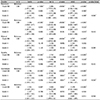1. Liu L, Wu J, Geng J, et al. Geographical prevalence and risk factors for pterygium: a systematic review and meta-analysis. BMJ Open. 2013; 3:e003787.

2. Saw SM, Tan D. Pterygium: prevalence, demography and risk factors. Ophthalmic Epidemiol. 1999; 6:219–228.


3. Cajucom-Uy H, Tong L, Wong TY, et al. The prevalence of and risk factors for pterygium in an urban Malay population: the Singapore Malay Eye Study (SiMES). Br J Ophthalmol. 2010; 94:977–981.


4. Wong TY, Foster PJ, Johnson GJ, et al. The prevalence and risk factors for pterygium in an adult Chinese population in Singapore: the Tanjong Pagar survey. Am J Ophthalmol. 2001; 131:176–183.


5. Hilgers JH. Pterygium: its incidence, heredity and etiology. Am J Ophthalmol. 1960; 50:635–644.


6. Bahar I, Loya N, Weinberger D, Avisar R. Effect of pterygium surgery on corneal topography: a prospective study. Cornea. 2004; 23:113–117.

7. Ishioka M, Shimmura S, Yagi Y, Tsubota K. Pterygium and dry eye. Ophthalmologica. 2001; 215:209–211.

8. Fernandes M, Sangwan VS, Bansal AK, et al. Outcome of pterygium surgery: analysis over 14 years. Eye (Lond). 2005; 19:1182–1190.


10. Jee D, Kim EC, Cho E, Arroyo JG. Positive association between blood 25-hydroxyvitamin d levels and pterygium after control for sunlight exposure. PLoS one. 2016; 11:e0157501.

11. Webber M, Krishnan A, Thomas NG, Cheung BM. Association between serum alkaline phosphatase and C-reactive protein in the United States National Health and Nutrition Examination Survey 2005-2006. Clin Chem Lab Med. 2010; 48:167–173.


12. Schoppet M, Shanahan CM. Role for alkaline phosphatase as an inducer of vascular calcification in renal failure? Kidney Int. 2008; 73:989–991.


13. Liuzzo G, Biasucci LM, Gallimore JR, et al. The prognostic value of C-reactive protein and serum amyloid a protein in severe unstable angina. N Engl J Med. 1994; 331:417–424.


14. Kabat EA, Furth J. A histochemical study of the distribution of alkaline phosphatase in various normal and neoplastic tissues. Am J Pathol. 1941; 17:303–318.


15. Tonelli M, Curhan G, Pfeffer M, et al. Relation between alkaline phosphatase, serum phosphate, and all-cause or cardiovascular mortality. Circulation. 2009; 120:1784–1792.


16. Cheung BM, Ong KL, Cheung RV, et al. Association between plasma alkaline phosphatase and C-reactive protein in Hong Kong Chinese. Clin Chem Lab Med. 2008; 46:523–527.


17. Ryu WS, Lee SH, Kim CK, et al. Increased serum alkaline phosphatase as a predictor of long-term mortality after stroke. Neurology. 2010; 75:1995–2002.


18. Wannamethee SG, Sattar N, Papcosta O, et al. Alkaline phosphatase, serum phosphate, and incident cardiovascular disease and total mortality in older men. Arterioscler Thromb Vasc Biol. 2013; 33:1070–1076.


19. Bandyopadhyay SK, Mukhopadhyay S, Chatterjee A. Study of alkaline phosphatase activity and DNA content of pterygium tissue showing its degenerative character. J Indian Med Assoc. 2011; 109:899–902.

20. Keating FR Jr, Jones JD, Elveback LR, Randall RV. The relation of age and sex to distribution of values in healthy adults of serum calcium, inorganic phosphorus, magnesium, alkaline phosphatase, total proteins, albumin, and blood urea. J Lab Clin Med. 1969; 73:825–834.

21. Chan-Yeung M, Ferreira P, Frohlich J, et al. The effects of age, smoking, and alcohol on routine laboratory tests. Am J Clin Pathol. 1981; 75:320–326.


22. Gundberg CM, Looker AC, Nieman SD, Calvo MS. Patterns of osteocalcin and bone specific alkaline phosphatase by age, gender, and race or ethnicity. Bone. 2002; 31:703–708.


24. Ketteler M, Giachelli C. Novel insights into vascular calcification. Kidney Int Suppl. 2006; 70:S5–S9.

25. Golub EE, Boesze-Battaglia K. The role of alkaline phosphatase in mineralization. Curr Opin Orthop. 2007; 18:444–448.

26. Maldonado O, Demasi R, Maldonado Y, et al. Extremely high levels of alkaline phosphatase in hospitalized patients. J Clin Gastroenterol. 1998; 27:342–345.


27. Chui J, Di Girolamo N, Wakefield D, Coroneo MT. The pathogenesis of pterygium: current concepts and their therapeutic implications. Ocul Surf. 2008; 6:24–43.


28. Doležalová V. Is the occurrence of a temporal pterygium really so rare? Ophthalmologica. 1977; 174:88–91.


29. Ramasamy B, Quah SA, Wishart MS, Hiscott P. Temporal pterygium: benign or not? Br J Ophthalmol. 2005; 8:1533–1534.

30. Awan KJ. The clinical significance of a single unilateral temporal pterygium. Can J Ophthalmol. 1975; 10:222–226.








 PDF
PDF ePub
ePub Citation
Citation Print
Print



 XML Download
XML Download